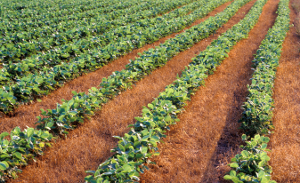5585 Guilford Road • Madison, WI 53711-5801 • 608-273-8080 • Fax 608-273-2021
www.agronomy.org
Twitter | Facebook
NEWS RELEASE
Contact: Hanna Jeske, Associate Director of Marketing and Brand Strategy, 608-268-3972, hjeske@sciencesocieties.org
Comparing Soybean Production Methods
MADISON, WI, AUGUST 19, 2011 -- In the Mid-South, twin-row soybean production is becoming a popular growing technique for soybean producers. An estimated 80% of the total hectares grown in the Mississippi Delta are planted in this configuration. While growers report this method increases seed yields, especially when used with specific cultivars planted in April or early May, there is no research data to support their claims.

Arnold Bruns, a USDA-ARS scientist at Stoneville, MS and author of this study, compared the effects of planting soybeans in twin-rows versus single-rows. The full results from Bruns’ study are published in the September-October 2011 issue of Agronomy Journal.
Single-row plantings were spaced 102 cm apart, while the twin-rows were spaced 25 cm apart with 102 cm centers. This study included plantings in April, May, and June at populations of 20, 30, 40 and 50 seed per square meter. The experiment was conducted on a Beulah fine sandy loam and a Sharkey clay, both common soils to the Mississippi Delta.
Twin-rows yielded more than single-rows on both soils. The number of pods per plant did not differ between twin-rows and single-rows. Drought and high temperatures likely reduced yields in 2010 compared to 2009. Delayed planting on both soil types resulted in decreased yields. Also, increasing seeding rates above 30 seed per meter resulted in no yield increases.
“While twin-rows did result in higher seed yields, the increase was only worth about $75 per hectare,” said Bruns. “It is necessary to consider a twin-row planter’s usefulness in other crops such as corn and cotton before investing in it for soybean production.”
###
Agronomy Journal is the flagship journal of the American Society of Agronomy. Articles convey original research in agriculture, natural resources, soil science, crop science, agroclimatology, agronomic modeling, production agriculture, and instrumentation.